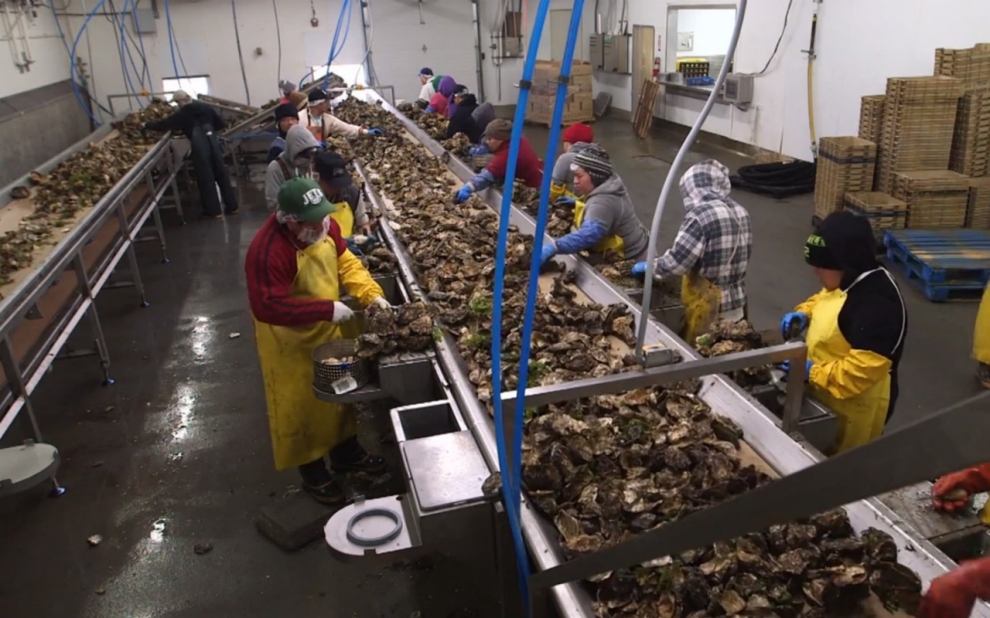Posted on Aljazeera America and OA: 19 Jun 2015 — By Lisa Fletcher and Brian Myers — Studies suggest carbon pollution could make oceans so acidic that oyster larvae shells dissolve in 45 days
SHELTON, Washington — Tucked into a hillside of pine, just above the Puget Sound, is perhaps the world’s most prolific nursery.
On any given day, hundreds of millions of sea creatures begin life under the watchful eye of marine biologist Benoit Eudeline. He raises oysters for the Taylor Shellfish Co., the largest producer of shellfish in the U.S., processing some 60 million oysters each year.
The oysters begin life in tanks filled with seawater, going from egg to a fully swimming larvae within 24 hours — the larvae so small, they can be seen only with a microscope.
But now these newly hatched oysters are under threat from a phenomenon known as ocean acidification.
Although it doesn’t get as much attention as melting ice caps or rising sea levels, ocean acidification is one of the most serious effects of greenhouse gas emissions. Nearly a third of the world’s carbon dioxide emissions, or about 22 million tons of CO2, is absorbed by the ocean every day. Scientists say this pollution has fundamentally changed ocean chemistry.
When carbon dioxide dissolves in water, it becomes an acid. That acid can be lethal to baby oysters, preventing them from forming shells, Eudeline said. And it’s not just oysters at risk; lobsters, crabs, clams and coral reefs are feeling the effects of ocean acidification too.
Ocean acidity is projected to increase by a factor of five by the year 2100, according to the National Oceanic and Atmospheric Administration. In water that acidic, the shell of a common sea creature will dissolve in 45 days.

This outlook has a significant effect on family businesses such as Taylor Shellfish, which began harvesting oysters in the 1890s. Diani Taylor, 26, is part of the fifth generation of Taylors to work on beaches.
“Ocean acidification specifically is an issue in the water that’s difficult to manage around,” said Taylor, who is currently a law student at Seattle University. “And it’s affecting us right now in our hatchery.”
She says it’s not unusual to have baby oysters die in very early stages. But now it’s happening at a rate they had not experienced before. At one point, she says, 75 percent of the oyster larvae were dying.
“Die-offs were happening more and more often, and it kind of became the norm, and we correlated that to the corrosive water that was coming into the hatchery,” she says. “It was really devastating for our oysters and really devastating for our farms.”
So Taylor Shellfish had to get creative. Eudeline began making adjustments to how they raise the oysters, treating the seawater in the hatchery with carbonates, buffers to reduce its acidity. Every day, the water is monitored, tested and tweaked to give the oyster larvae a fighting chance.
While buffering the water hasn’t been a complete success, he says, it’s a good start. But he believes that ocean acidification is far more insidious and that the scientific community is not yet aware of all the effects that come with it.
Taylor says they’re doing everything they can, at the hatchery and in the nation’s capital, to confront ocean acidification. Last year she and her father traveled to Washington, D.C., to lobby lawmakers on the problem. She says the future of the shellfish farmer is becoming clearer to the general public, but she knows there’s a long way to go.
“This is really a global issue. It’s a big problem, and we want to be as vocal about it as we can be,” she said. “We’ve been around 120 years, and we want to be around for another 120 years.”
Read this story and watch the video on Aljazeera America.